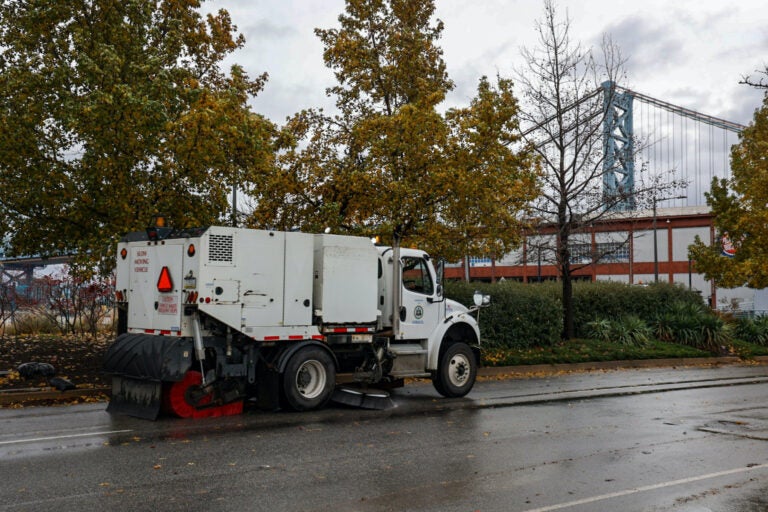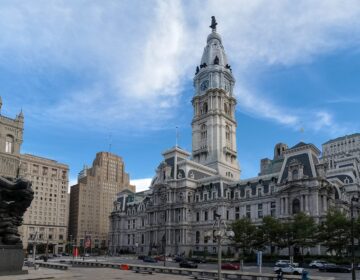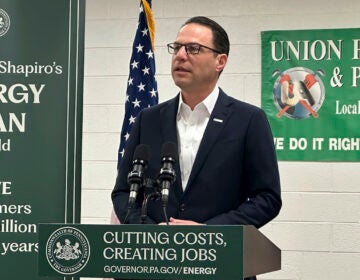The city of Philadelphia’s vehicle fleet is getting cleaner, but it has a long way to go
In 2023, the city reached a benchmark of nearly 250 electric vehicles. That’s out of a fleet of over 5,000 vehicles.

Philadelphia street sweeping vehicles worked to clear debris from Columbus Blvd. after a storm brought heavy rain to the region and the Delaware River overflowed onto the road on December 18, 2023. (Kimberly Paynter/WHYY)
This story is part of the WHYY News Climate Desk, bringing you news and solutions for our changing region.
From the Poconos to the Jersey Shore to the mouth of the Delaware Bay, what do you want to know about climate change? What would you like us to cover? Get in touch.
Garbage trucks, police cruisers, and Water Department vehicles criss-cross the city of Philadelphia — spewing planet-warming pollution from their tailpipes.
For the past several years, the city has been trying to reduce the carbon footprint of the vehicles it owns. Last year the city reached a benchmark of nearly 250 electric vehicles — but that’s just a small fraction of the city’s fleet.
“We do have a ways to go,” said Dominic McGraw, deputy director of energy services & operations of the city’s Municipal Energy Office. “But I will say, too — it’s not going to be instant.”
In 2021, the city released a plan to replace the more than 5,000 vehicles it owns with electric vehicles or ones that run on lower-emissions fuels.
The city’s strategy is to replace its vehicles with cleaner versions gradually, as they retire — rather than all at once. The city plans to stop buying new fossil fuel-powered vehicles by 2030.
As a candidate, new Mayor Cherelle Parker backed the city’s commitment to reach carbon neutrality by 2050, established under former mayor Jim Kenney. Carbon emissions from transportation in Philly have grown in recent years, making up over a quarter of overall emissions in the city.
The city government’s fleet makes up less than 1% of Philly’s overall emissions, but more than 15% of municipal emissions — a growing share as emissions from city buildings decrease as a result of a cleaner grid and energy efficiency upgrades. McGraw sees this as a further incentive to electrify the city’s fleet.
“We’re definitely seeing a reduction [in the city’s carbon footprint] already and we’ll continue to see reduction as it moves forward,” he said.
Electrifying the city’s fleet is not just good for the climate. Eliminating tailpipe emissions, particularly for diesel-powered trucks, reduces unhealthy air pollution in neighborhoods that can lead to respiratory issues like asthma.
“It’s a good public example — you’re showing your residents how you can move to a cleaner fleet,” said Sean Greene, who heads the Office of Freight and Clean Transportation at the Delaware Valley Regional Planning Commission. “You can save money on fueling and maintenance, as well as reducing not only … the carbon dioxide that contributes to climate change, but also those emissions that hurt people’s health.”
So far, most of the battery electric vehicles the city has bought have been in the Department of Licenses and Inspection and are smaller vehicles like sedans, SUVs, and vans.
But the bigger vehicles are harder to electrify, McGraw said. For example, the city’s trash trucks double as snow plows, and need to be ready to run 24 hours a day in a snow emergency — a potential problem without fast chargers. Batteries would also add weight to already heavy fire trucks.
“We’re still waiting for the technology to shift, … but we’re watching other cities as they’re prototyping different things,” McGraw said.
Electric trash trucks and fire trucks are starting to be deployed in the U.S., but still in very small numbers and with upfront costs higher than those of diesel trucks.
“[Heavy duty electric vehicles] are starting to become available, but it’s still a work in progress,” Greene said.
The city of Philadelphia has been replacing some of its diesel trucks with compressed natural gas, which has lower tailpipe emissions but still contributes to climate change. The city could look into offsetting the emissions from these vehicles with credits from renewable natural gas projects, which capture gas from sources such as landfills or sewage treatment plants to be burned in place of fracked gas, McGraw said. Green hydrogen may also be an option for the city’s heavy duty vehicles at some point, he said.
Replacing diesel vehicles with natural gas-powered vehicles feels dated to John Paul McDuffie, a professor who studies vehicles and mobility at the Wharton School of the University of Pennsylvania.
“It just doesn’t look so good anymore — particularly when you have the emission-free options of battery electric,” McDuffie said. “The city definitely ought to be really seriously exploring the options of what’s available now or what will be available the next five years.”
The biggest challenge for the city has been growing its network of electric vehicle chargers, McGraw said. Space at its existing gas fueling stations can be too tight to add chargers, or electric infrastructure can need costly upgrades — and the chargers themselves can be expensive, he said.
“I think the city is credible when they claim that the delays are not so much in the vehicles per se as they are in all the various issues around charging,” McDuffie said.
But federal legislation passed in recent years has encouraged domestic manufacturing of charging equipment and subsidies to install them, McDuffie said. The city expects to be able to receive direct payments, similar to tax credits, to buy new electric vehicles and possibly chargers under the Inflation Reduction Act.
“I think we’ll start to see availability of that equipment along with the funds to install it starting to come much more quickly,” McDuffie said.

Subscribe to PlanPhilly
WHYY is your source for fact-based, in-depth journalism and information. As a nonprofit organization, we rely on financial support from readers like you. Please give today.








